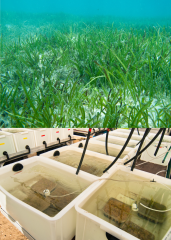NERP TE Project 5.3 - Vulnerability of seagrass habitats in the Great Barrier Reef to changing coastal environments (JCU)
Project summary
Seagrass meadows are a vital habitat in tropical marine ecosystems. Along the coast they trap sediments and absorb contaminants which would otherwise pollute the Great Barrier Reef (GBR). Seagrasses are highly affected by water clarity and so are negatively impacted by run-off and other factors that increase turbidity (water cloudiness). This project will provide information about how seagrass responds to the interactive effects of different levels of light, nutrients and salinity and will contribute to the development of thresholds for the water quality parameters most likely to affect seagrasses.
Why this research is needed
Apart from the direct impact of tropical cyclones, declines in seagrass abundance and distribution can be attributed to decreasing water quality, particularly caused by the direct and indirect effect of sediments carried by flood plumes. Research on the interactive effects of changing light, nutrients and salinity levels on seagrasses is required to establish water quality thresholds in order to effectively manage and conserve these essential GBR habitats. The outcomes of the research will also help with the interpretation of the cause of changes in seagrass abundance, and therefore, management priorities.
Research user focus
The outcomes of the project will be useful for state and Australian Government agencies, NRM bodies, NGOs, local government and industry, including fishing, mining and agriculture. Research users include the Great Barrier Reef Marine Park Authority (GBRMPA), DSEWPaC (particularly the Reef Rescue initiative), the Queensland Department of Environment and Heritage Protection, Queensland Department of Agriculture, Fisheries and Forestry, Reef Plan and Terrain NRM.
Outcomes
- Quantified level of exposure of seagrass meadows to broad-scale changes in water quality associated with flood plumes in GBR coastal regions
- Improved knowledge of seagrass responses to the interactive effects of light, nutrients and salinity
- Refined thresholds of concern for seagrass health, contributing to the development of water quality guidelines in relation to light, nutrients and salinity
- Experimentally tested indicators of seagrass status adopted by the Reef Rescue Marine Monitoring Program (RRMMP) in response to changes in water quality
- Improved understanding of likely future trends for GBR ecosystems, which will contribute to risk assessment reports for the GBR
- Experimental verification of water quality response models.
Reports, Publications and News
For more information see Project 5.3 'Vulnerability of seagrass habitats in the Great Barrier Reef to flood plume impacts: light, nutrients, salinity' on the NERP Tropical Ecosystems Hub site.
Images
Datasets

This dataset consists of one data file from a 10 week aquarium experiment manipulating salinity and measuring density, reproduction and growth responses of three tropical Indo-pacific seagrass species (Zostera mueller, Halodule uninervis and Halophila ovalis).
The Reef Rescue Marine Monitoring Program (RRMMP) has identified that seagrass meadows along the Great Barrier Reef are in a state of decline. This project will undertake desktop analyses to quantify the exposure of seagrass meadows to flood plumes. Aquaria experiments will measure responses of seagrass to variation in light, nutrients and salinity. This project will also use use True Colour Remote sensing images, to derive flood plume exposure and relate to changes in seagrass abundance and composition.





